Luxli Cello RGB LED Light
LED lighting has come incredibly far in a few short years, from the bulky, expensive, low output and bad color rendering on the early panels, to the lightweight, affordable, bright and color accurate LEDs that are available in all shapes and sizes today.
The first wave of LED lights were mostly all daylight rated bulbs, and then came the bicolor flavors for conveniency, but the underlying progress was in producing brighter and better quality lights with a near perfect daylight or white output for good skin tones.
So now that we have conquered near perfect white lights, it only makes sense that we move on to the rest of the color spectrum. Enter the next phase of LED lights: RGB aka “party lights.”
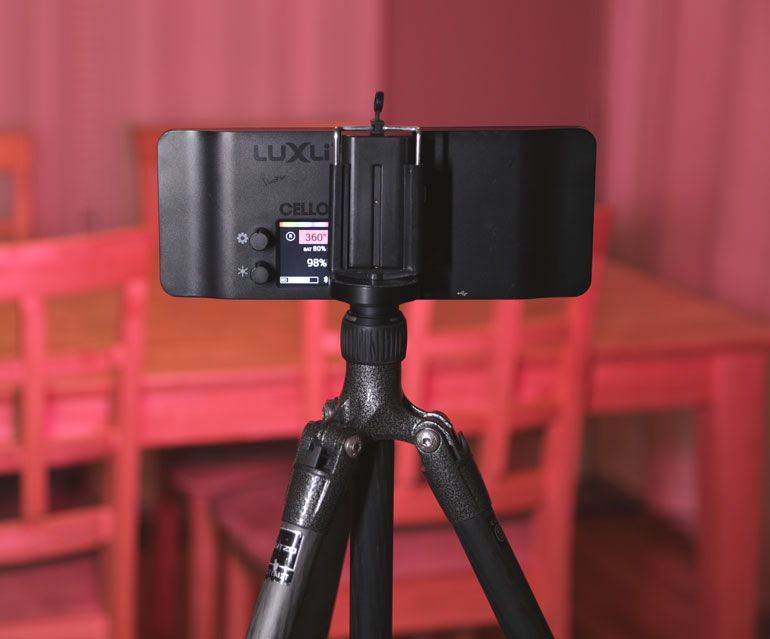
Apart from creating an even more perfect white output, you may wonder, why would anyone need an orange or purple light, especially one that can dial in one of a hundred thousand colors with pinpoint precision.
Well, why not? Maybe we don’t fully grasp all the possibilities with an emerging lighting technology just yet. Maybe it’s not so bad if in five years all of our lights have the capacity to dial in precise colors or replicate industry standard gels.
With those questions in mind, we set out to review the newly released Luxli Cello 10” RGBAW light. The Cello is a wonderful entryway into the world of RGB lighting, in that it's super lightweight and small, easy to use and power with standard batteries, and won't break the bank. But it also has a multitude of features that enables filmmakers to start experimenting with RGB lighting in creative ways.
Luxli Cello Overview
First, lets take a look at some of the Cello specs. At about 10 inches across and under 4 inches high, the Cello is small enough to go anywhere, including on top of your camera. (Although, Luxli's 5-inch Viola version might be better suited for on-camera use, but we’ll get to that in a bit.) It weighs under a pound.
Each of the 176 LEDs are a little different than the LEDs you might have in your other panels, in that they each have an RGB circuit on it, and a fairly heavy duty plastic housing around each bulb. They are actually bicolor Phosphor LEDs which are comprised of two diodes, which are combined to output color accurate white and the full color spectrum. That's what the A and W stand for - Amber and White - the two diodes.
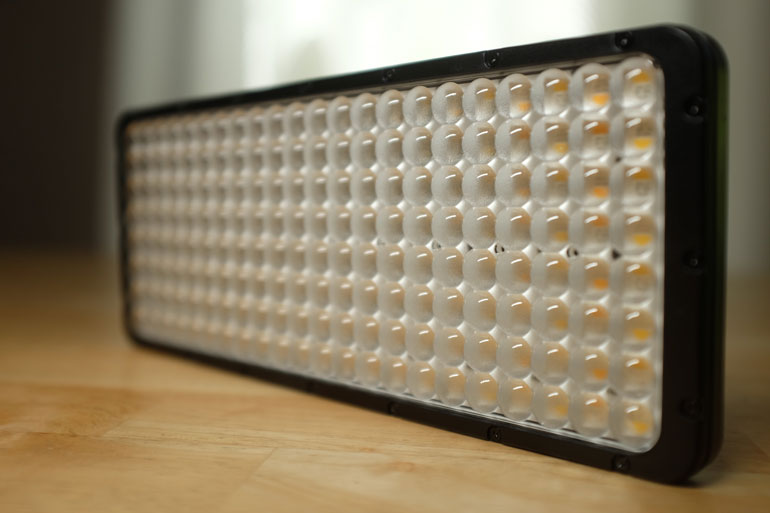
The Cello has 0-100% continuous dimming, which is a nice feature for an on-camera light when your subject is a foot away and you need just the smallest bit of light.
For example, Luxli has told us they know of night photographers using the Cello at 1% output to make 25-second long exposures, at f/2.8 / ISO 6400, on objects dozens to hundreds of feet away. That's a lot of versatility in a light.
It consumes 24W and can be powered by AC adapter or a standard Sony NP-F (aka L-series) battery. The default package comes with one battery and a charger. A good charger too - the kind that has the plug built into the charger so you don't need to carry power cables around.

As for brightness, the Cello outputs 1200 lux at one meter, which is quite good for a light this size. The beam angle is 72 degrees - not too wide, not too narrow.
As a comparison, our go-to on-camera light for years has been the Cineroid L10-VCE, which is about the size of a pack of cards, also powered by a Sony NP-F battery, can be dimmed to 0%, has a 120 degree beam angle, outputs 2700K to 6500K variable color, and it can do 360 lux at one meter, with only 96 LEDs compared to the Cello’s 176 LEDs.
Even at 360 lux, the Cineroid is blindlingly bright from a meter away, like way too much power than any on-camera light ever needs, so with the Cello’s 3x brightness over the Cineroid, let’s just say you’ll never need another on-camera light. But we’re pretty sure most buyers will use the Cello for off-camera lighting, and opt for the smaller Luxli Viola for on-camera use instead.
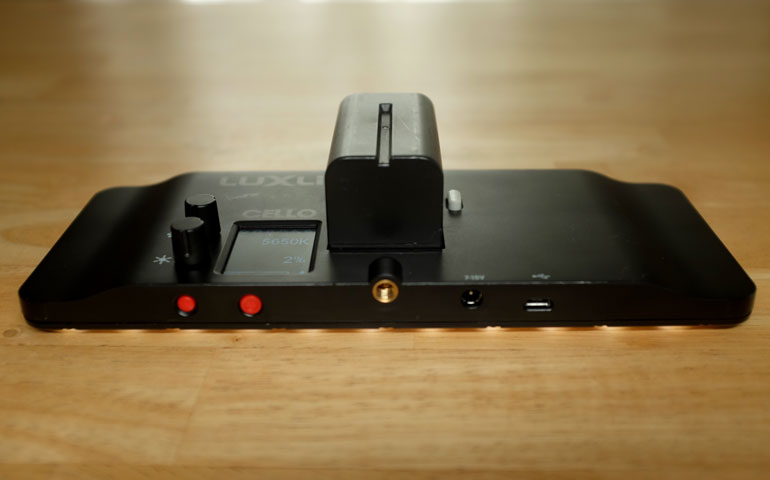
One thing to note is the build quality on the Luxli Cello is really good. It feels like a well designed, unique product, rather than a hodge podge of off-the-shelf parts put together. The battery terminal, buttons, and 1/4-20” thread are often the first to go on these kinds of small lights, so we are very happy to see solid connections that will hopefully last a long time. As a bonus, the Cello comes with a very nice ballhead shoe mount, not the same ol’ ballhead that comes standard with many camera accessories today.
The Cello has a digital display which shows you the variety of color and gel choices, along with dimming control, and there’s an actual battery meter, which to be honest is a god send. We travel with 10-20 Sony batteries at any given time, and it’s always a battle trying to figure out which battery is full, partly used, or empty. Often we find out the answer in the middle of the interview, when a light goes out at the most inopportune time.
RGB Lighting
Now let’s look at the color options on the Luxli Cello. In the LCD menu, you can choose between three operating modes: RGB Color Mode, CCT Mode, and Gel Filter Mode.
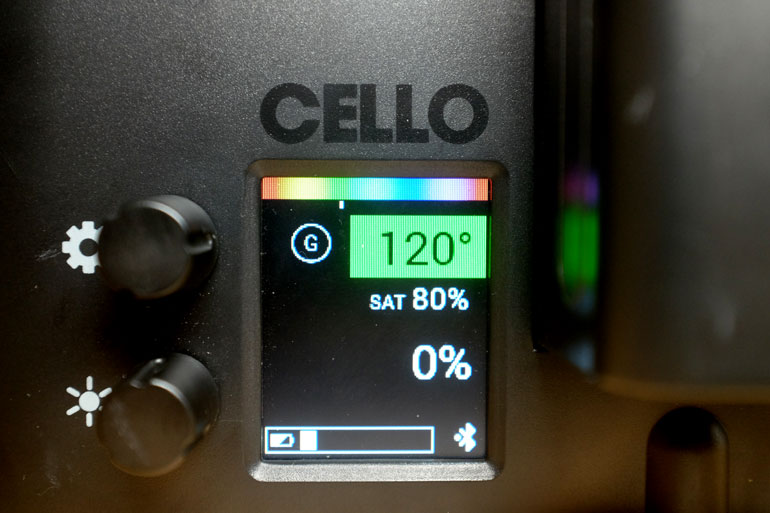
In RGB Color Mode, you can scroll through the RGB color wheel in 1 degree increments. This is probably the easiest way to dial in a color if you're simply watching the output and not trying to be precise. In RGB mode you can also choose the Saturation, which is very important because you can tone down the light's color intensity without reducing its brightness. Saturation adjusts in 10% increments from 0-100%.
In the CCT Mode (Correlated Color Temperature), you get a more traditional color temperature selection of 3,000 to 10,000 Kelvin, in 50K increments.
In CCT mode, there's also a shortcut for switching directly between Tungsten and Daylight, by just pressing in on the settings button.

As you scroll through the kelvin values, the notch will move under the standard photography icons such as tungsten , fluorescent, daylight, cloudy, and so on.
And in the Gel Filter Mode, you get a unique feature which enables you to imitate industry-standard color gels. You set your white balance first, and then select between 150 colored gels, like 1/4 CTO, for example. If you’re accustomed to using gels, or you’re trying to match other lights on set, this feature can be very handy.
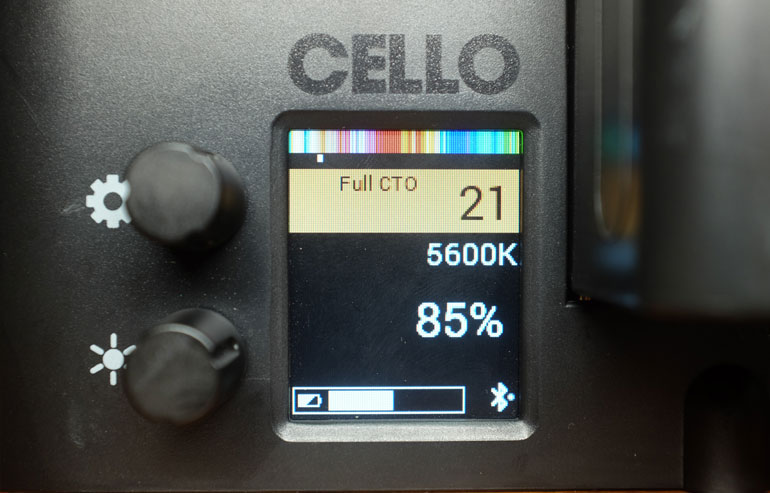
Luxli Conductor App
Although it the Luxli Cello is a very nice light by itself, it becomes a much more powerful tool with the companion Conductor smartphone app. There is both an iOS version and an Android version. The Cello and Viola are part of Luxli’s Orchestra line, so it only makes sense to call the app “Conductor.”

In addition to remotely controlling the Cello’s brightness and color settings, you can also combine a number of Cello and Viola lights and sync them all with one app.
This is a very handy feature if you’re using a series of these lights to create a textured background or scene. With the app, you can stand back and dial in the lights’ colors and output all at once, rather than adjusting each one individually. This makes the Luxli lights incredibly useful for anyone building a scene with small lights placed around a room (and it’s where the 0-100% dimmer control is also handy).
The other thing you can do with the app is use an eyedropper feature to match the Luxli color to an image on your phone. That’s pretty cool, but even more impressive, you can also record a video or find a Youtube clip, and have the Luxli imitate the moving image.
Yes, it can change colors independently to simulate a real-life light scenario, such as police lights, a flickering TV screen, a campfire, you name it. Just load up a video and Luxli will imitate the light color and movement.
Our Impressions
In the short time that we’ve used the Luxli Cello, we’ve been impressed with it enough to bring it along to every shoot. It doesn’t take up much space and it’s quite a powerful tool, so why not bring it along?
For our simple purposes, we’ve mostly used the Cello as a hair light for interviews, and as a handheld or creatively placed light when we need to brighten a subject during B-roll shooting. We’ve found the the light to be very sturdy and well built, it has an excellent battery life, easy to use, and can be attached to standard light stands as well as a Joby Gorillapod or Dinkum ActionPod clamp for more flexible placement.
As a hair light, the Cello is actually very handy because you don’t always need or want the hair/rim light to be the exact same color as your key and fill lights. Since the hair light doesn’t touch skin tone, you can modify the light’s color to help add a little creative seperation between your subject and the background.

Luxli hair light set to yellow, with subject lit by Westcott Ice Light 2 Daylight LED
For example, if your subject is lit with daylight rated lights, and your background is a standard room with white walls and some brown furniture, you could make your hair light a slight yellow to help your subject stand out. That effect can be too distracting with a tungsten hair light in a daylight scene, but with the Cello, you can dial in just a slight variation of color.
rgb lights in documentary and corporate filmmaking
Of course, many people who look at RGB lights like the Cello will immediately assume it’s for narrative or creative filmmakers (hence the term “party light”). Being able to imitate a flickering TV screen or police car is a prime example of the Cello’s use case in a narrative environment.
RGB lights are also extremely handy in music videos, where creative lighting is essential to make a music video stand out. Here's an example of five Luxli Cellos being used to make a music video.
But in addition to the hair light trick mentioned above, there are a few other good applications for an RGB light like the Cello in documentary or corporate filmmaking.
For one, doc and corporate video shooters frequently walk into some of the most bizarre and terribly lit areas imaginable. And we often don’t have a choice of alternative locations to shoot our B-roll scenes or interviews. Sometimes, we don’t even have the option to kill the overhead lights, and so we’re stuck with what we have.
In this case, having the ability to dial in an overall room color is a huge advantage to having only tungsten or daylight lights. Better yet, the ability to take a picture of the room and have the Conductor app identify the primary light temperature in a mixed light environment is a really useful tool.
If we can get to a point where all of our lights - including our panels, LED fresnels, and flex lights - can be able to match overall room light or precise colors, then we will be in a much better position as documentary and corporate filmmakers. It appears there’s already a Luxli large panel version of the Cello and Viola, so we’re almost there. Check out the Timpani 1x1 specs here.
RGB Light for Colored Backgrounds
Ok so there’s not a lot of documentary or nonfiction scenarios where you want to shine a purple or orange light onto a subject’s face, unless you’re going for a specific look or trying to match stage lights during a performance.
But for backgrounds - behind interviews and B-roll scenes - you most certainly can and perhaps should use an RGB light like the Luxli Cello in a variety of color modes.
Why? Because when your subject and background have a similar color tone to them, you can choose an entirely different color to light the background, to give a much more distinct foreground/background seperation.
We’ve been taking this approach for a few years by pointing tungsten lights in the background, while using daylight lights for our subject.
However, this hasn’t always worked well, like when our subject’s clothing and background are tan or yellow/orange, where an even more emphasis on orange in the background becomes distracting.
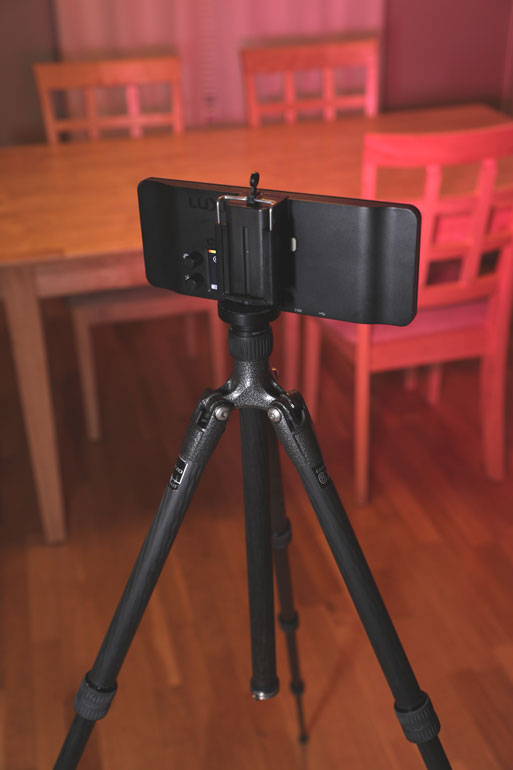
In a pinch, you can place the Luxli on a featherweight tripod like Gitzo 1545T, held by a simple smartphone clip.
In this case, you would want to neutralize the background and give it a cool hue. Being able to dial in a tone of blue that achieves this effect is a very nice addition to our arsenal of tools.
You might ask, why can't you simply apply a color filter in post, if you want a particular look? Well, the advantage here is you can retain accurate skin tones with your key light, while shifting only the background colors. It would be incredibly time consuming (and maybe sloppy) to try to mask your subject in post, while applying a color filter to the background.
The following images were all taken with a Canon 1DX Mark II with a Canon 24-105mm f/4 lens, in 5600K, with our lovely subject lit by a single Westcott Ice Light 2. These examples were taken to illustrate our point - in real shoots you would probably want to dial back the color saturation quite a bit.

Luxli Cello set to 5600K, to match the Wescott Ice Light 2

Cello set to yellow

Cello set to blue

Cello set to green
Luxli Orchestra Line
If you’re convinced you need to add a RGB light to your kit, how do you choose between the 3 currently available Luxli Orchestra lights?
Luxli Viola 5-Inch RGBAW On-Camera Light
The Luxli Viola is 5-inches and is best suited for on-camera work, as well as for colored texture pops in the background. While they’re not exactly dirt cheap, you may want a few of these to give you the ability to place them throughout a scene. With the app, you can decide whether to sync all of them to one color, or give them each a different hue.
The Viola has 88 LEDs compared to the Cello’s 176, so you can expect 50% the output, but twice the battery life. At around 600 lux at 1 meter, that puts the Viola at a higher output than the small Aputure MX (200 lux at 1 meter, but wider 120 beam angle) and Cineroid L10C-VCE light (360 lux at 1 meter, also at 120 degree beam angle).
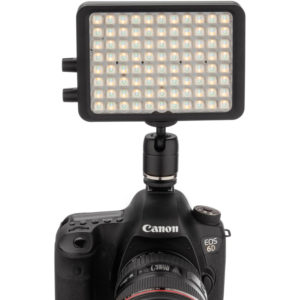
In summary, the Viola looks to be an excellent choice for a powerful little light. It looks to be made with the same level of quality manufacturing, and also comes with the same accessories.
Luxli Timpani 1x1 RGBAW LED Panel
The Luxli Timpani is a 1x1 panel with all the same RGB color choices, menu selections, and Conductor app functionality as Luxli’s other Orchestra lights.
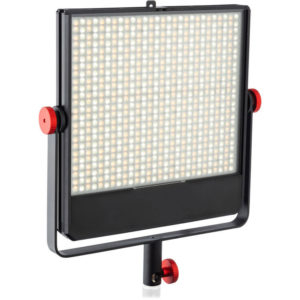
One slight difference is the Timpani features 10 preprogrammed special effects for realistic lighting tricks, such as fireworks, police lights, or a campfire. We think this is probably similar to the preprogrammed effects found in the Rotolight's Neo and Anova lights.
With 672 of these special LEDs, even in simple daylight or tungsten, you’re still getting 4100 lux output at 1 meter, which is impressive even if the Timpani didn’t have any of the RGB functions. As a comparison, the Aputure Amaran AL-HR672W also has 672 LEDs - though daylight only - with a similar beam angle at 75 degrees, but only outputs 2080 lux at 1 meter.
Of course, the Amaran is 1/4th the cost of the Timpani, but it shows just how rapidly LED technology is advancing in terms of color accuracy and output, even just a few years after the Amaran was released.
So if you’re looking to use RGB lights as your key or fill, the Luxli Timpani is a superb choice among today’s many LED light offerings. It has a V-mount plate and can also be powered via an XLR cable to AC adapter. The Timpani comes with a yoke and has a medium duty build at under 7lbs for the fixture.
Luxli Cello 10-Inch RGBAW Multipurpose Light
For our buck, we think the Luxli Cello has the perfect size, weight, and punch for most people interested in carrying around an RGB light. At just under a pound, it takes up very little space, uses Sony NP-F batteries you’re most likely already carrying, and you never know when it’ll save your bacon on a shoot.
We believe the Luxli Cello is a fantastic introduction into the world of RGB lights, and it will inevitably lead creative shooters to find all kinds of new use cases beyond what we've presented here. In the meantime, the Cello has earned a well deserved spot in both our documentary and corporate filmmaking gear bags.
Luxli Cello - Check price at B&H Photo Video

